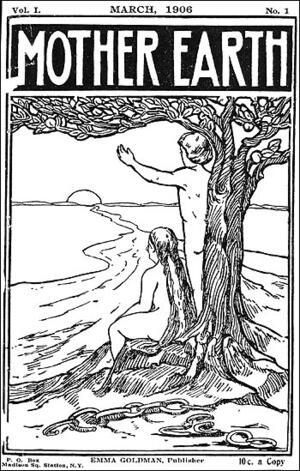Writing the Feminist Revolution
The cover of the inaugural issue of Mother Earth reflects Goldman's aspirations for the anarchist movement, which she hoped would usher in a new dawn. The couple in the drawing may represent a new Adam and Eve, who have broken the shackles that have traditionally bound them.
Courtesy of the Emma Goldman Papers.
Most women in my town know that if they need help with anything related to their health, they can march past the handful of protesters and enter the doors of the Emma Goldman Clinic. Yet, few of them actually know where that name comes from.
Emma Goldman was born in 1869 in Kovno, Lithuania. She and her sister moved to the United States in 1885, and she became interested in anarchism and activism. Goldman was a formidable activist and was often arrested and censored for her belief in and work toward anarchy, free love, and reproductive rights (specifically, birth control access). She was the editor for Mother Earth, an anarchist periodical devoted to social science and literature. Goldman used writing as a vehicle to educate the public and inform them of her views, especially on birth control and women’s sexuality.
As a politically active feminist living in the Trump era, I approach activism in the form of protest. Though I take action through rallies, walkouts, and other marches, I feel like there is a lack of action through words. Feminism, obviously, doesn’t look the same as it did in the past. That is not only due to a shift in the movement’s goals and an expansion in its intersectionality; it’s also because of shifts in the way that the movement communicates its message. I believe that, if Goldman were still alive today participating in contemporary feminist politics, her emphasis on writing and lecturing would reshape the modern feminist movement.
I run social media for two groups: a local organization, Students Against School Shootings (a March For Our Lives chapter), and the caucus club that I founded at my school. When we are working to gain momentum for our movements and causes, almost all of our outreach happens through social media. On these platforms, information has to be digestible.
Yet, it’s not only the advertising for our events that has to be digestible; the events themselves have to be as well. Thanks to the proliferation of social media, it feels like our attention spans are miniscule. Anything that isn’t a spectacle, like a march or rally, or anything that requires too much work or too much involvement won’t draw a crowd. This isn’t to say that modern day activism is anywhere close to being dead or misguided; It’s simply to say that activism today has to make news. It has to be worthy of both participants and politicians’ time.
Emma Goldman was quite the spectacle in her day. She was arrested on multiple occasions for distributing pamphlets about birth control and family planning. Yet, she also found ways to be successful in her activism that didn’t involve holding a march. She fought back the government’s censorship of her political views through her writing. She fought censorship with free speech. Her writing was her weapon against political oppression. It was sustained, and it took time and effort to write her work. She gave lectures around the nation. She was able to find victories and make individual impacts that weren’t necessarily newsworthy. Emma Goldman was an anarchist and a radical, and the way she approached activism through her writing and speeches was effective. By informing the public and raising awareness through her writing, she was able to help her movement.
Some of the most prominent movements in modern day feminism, #metoo and #bringbackourgirls, were started through social media. I don’t know that anyone in my generation would say that this century’s wave of feminism has had our “awakening” through literature, the way second wave feminism had the Feminine Mystique by (another Jewish woman) Betty Friedan.
In my mind, and in others’, feminism has become commercialized. Writing like Goldman’s is often locked up in academia. The average person doesn’t have access to JSTOR where they could read the latest peer-reviewed paper on feminism. While marches and rallies can make headlines and incite systematic change on a governmental level by pressuring politicians, it doesn’t always reach and influence everyday people to the same extent; signs with catchy slogans and hashtags don’t provide the context and education for those that don’t have access to it.
While the intent of the caucus club at my school was initially to educate people, specifically non-activists, through discussion, the only people who are actually involved in the club are highly politically active. While there is nothing wrong with that, we’ve found it to be difficult to spread our message to those who haven’t heard it because, to be frank, the everyday high schooler simply doesn’t seem to care unless it involves a large-scale event.
Emma Goldman was able to rally everyday people. She was able to educate non-activists through her writing and speechmaking. It seems rarer today to see activists describing themselves as “writers” in their bios. Rather, activists are rally holders and social media influencers. There is so much more.
Of course, we can’t see a rise in activism through writing if society just won’t read it, and with this new digital age, it’s difficult to spread feminist messages without online trolls and fake news claims. Yet, that’s exactly why I think writing is so necessary in activist movements today; every time that Goldman’s writing was censored, she fought back by writing more. Modern day feminists need to find a way to make contemporary messages more accessible to the public while still staying true to the movement’s roots; only then can we engage deeply and educate widely.
This piece was written as part of JWA’s Rising Voices Fellowship.






